




Compositions



3) Utopia 2






Comments and Feedback
 THANK YOU GUYS FOR THE LOVELY COMMENTS <3
THANK YOU GUYS FOR THE LOVELY COMMENTS <3




Compositions



3) Utopia 2






Comments and Feedback
 THANK YOU GUYS FOR THE LOVELY COMMENTS <3
THANK YOU GUYS FOR THE LOVELY COMMENTS <3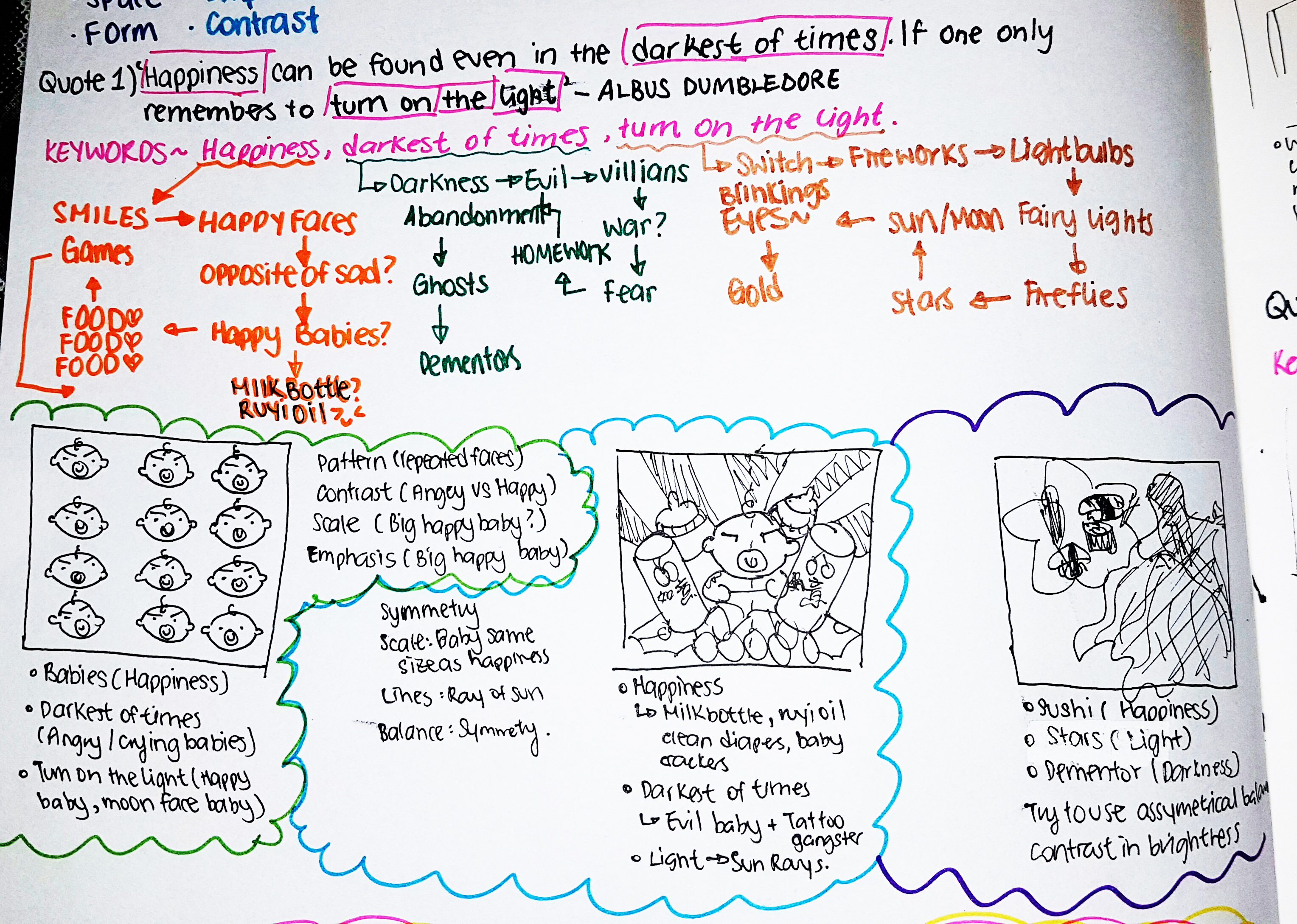
Quote 1) “Happiness can be found, even in the darkest of times, if one only remembers to turn on the light.”
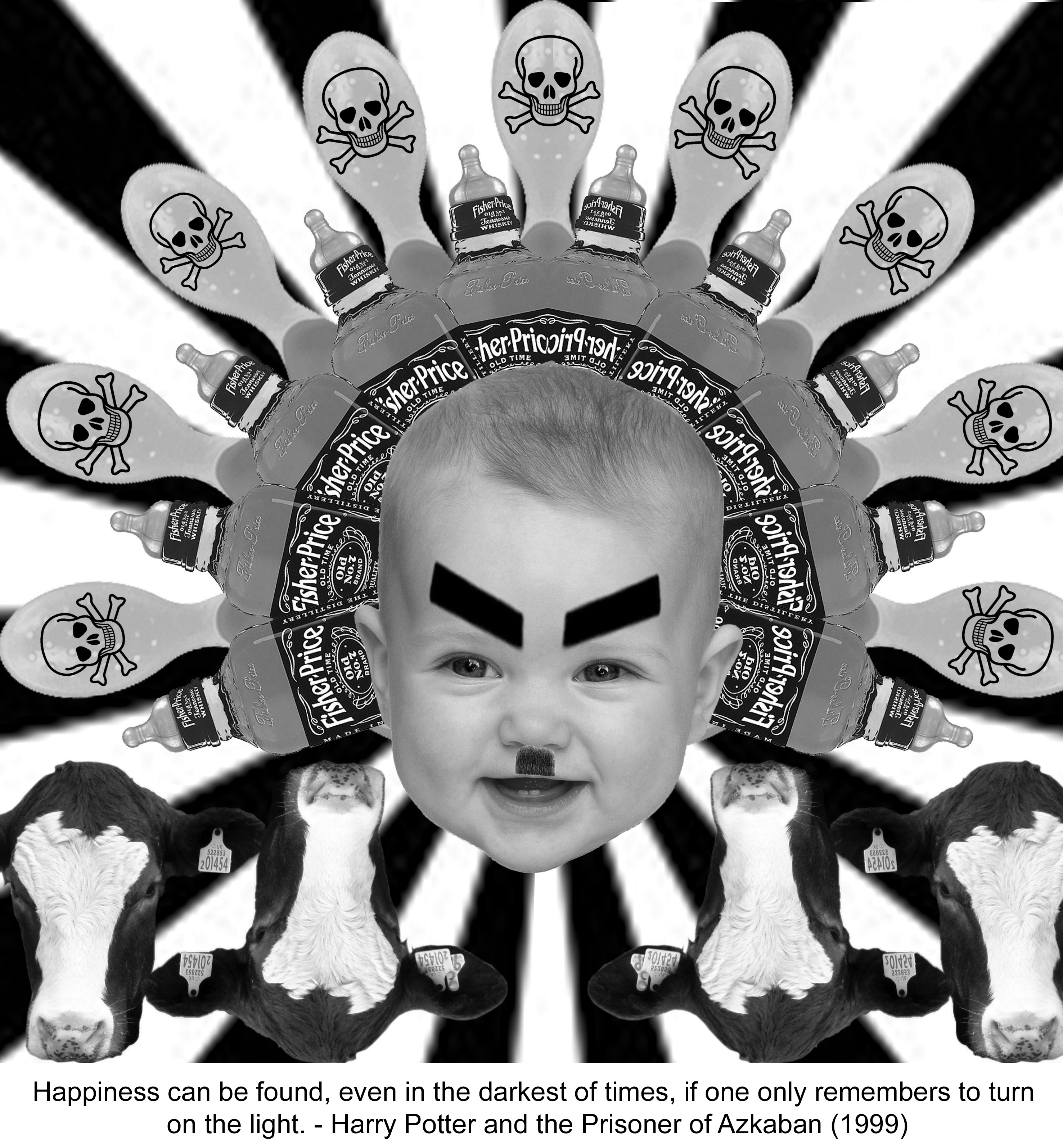
Keywords
Can’t be together-> distance and separation
Heart -> warmth in cold , maternal love, child
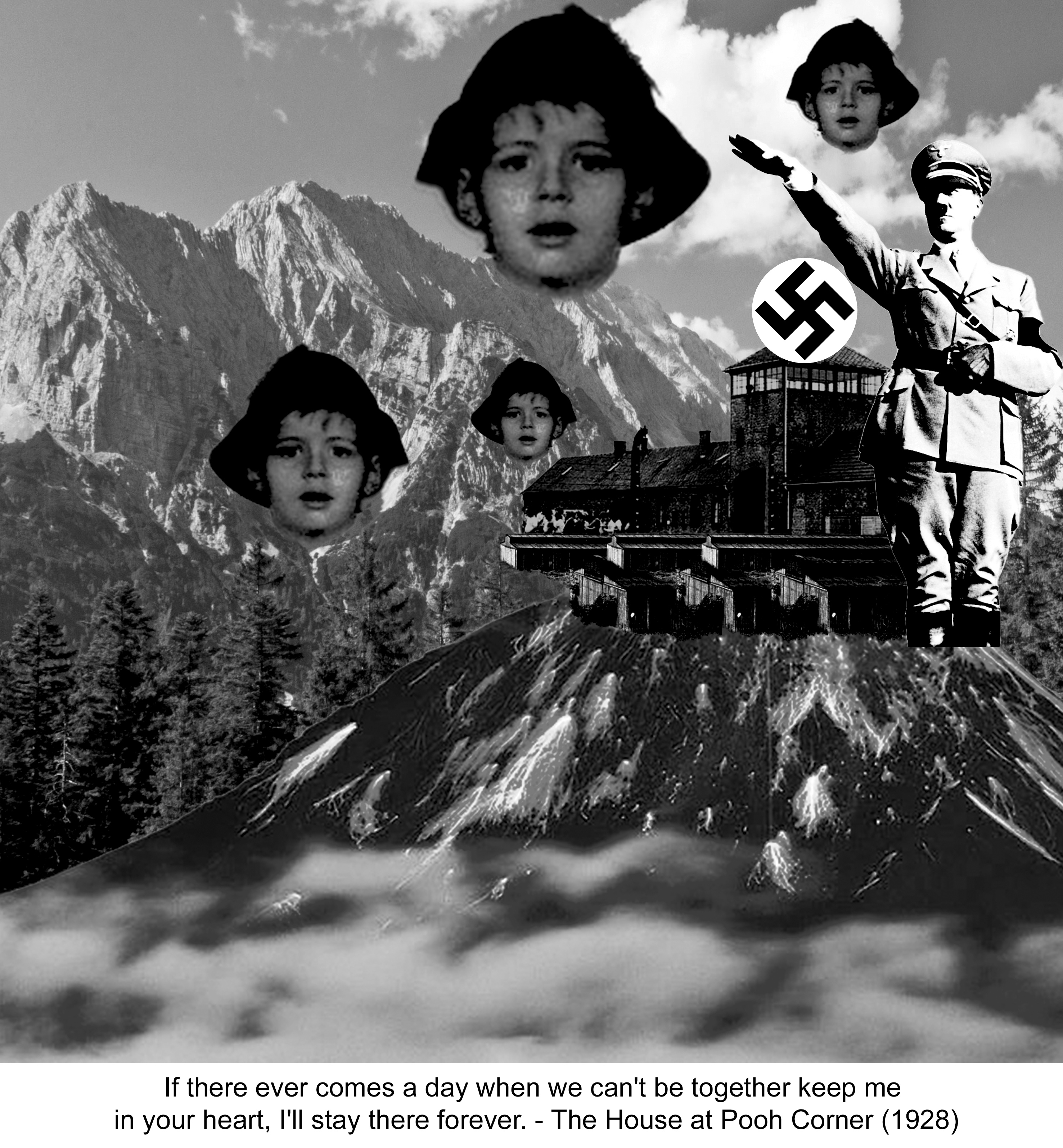

Quote 4) “Come with me where dreams are born, and time is never planned.”
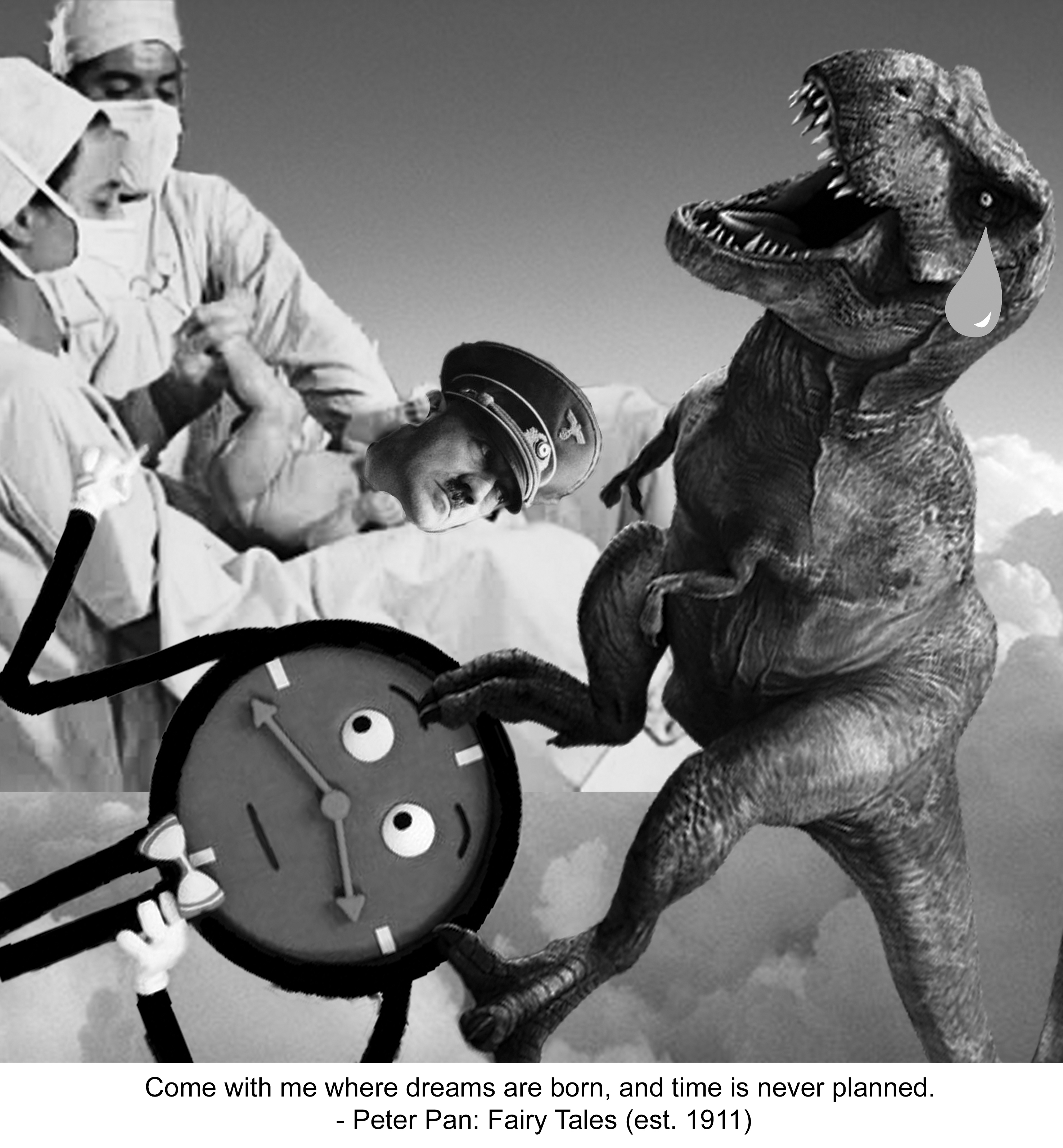
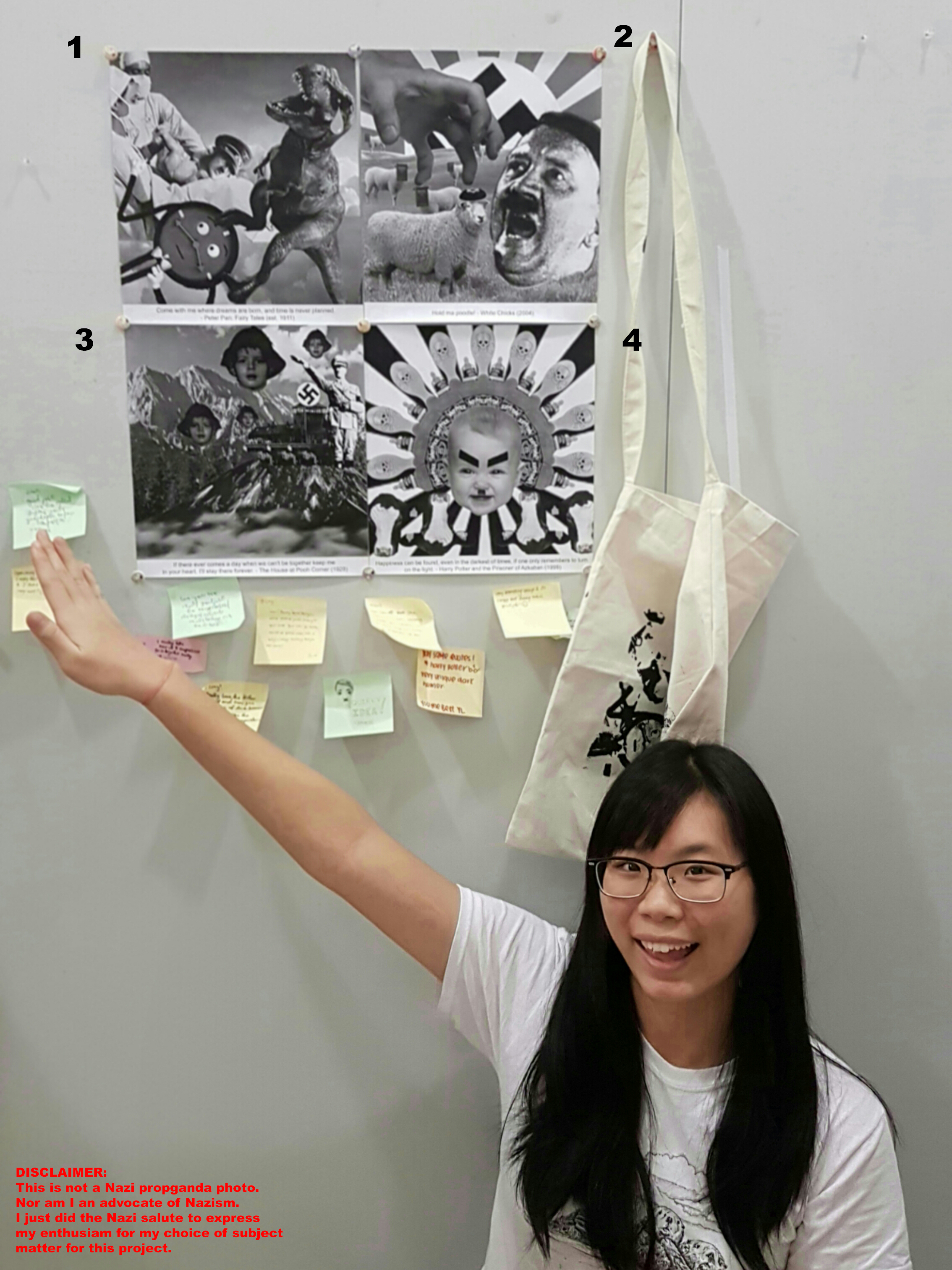
Sequence is as followed.
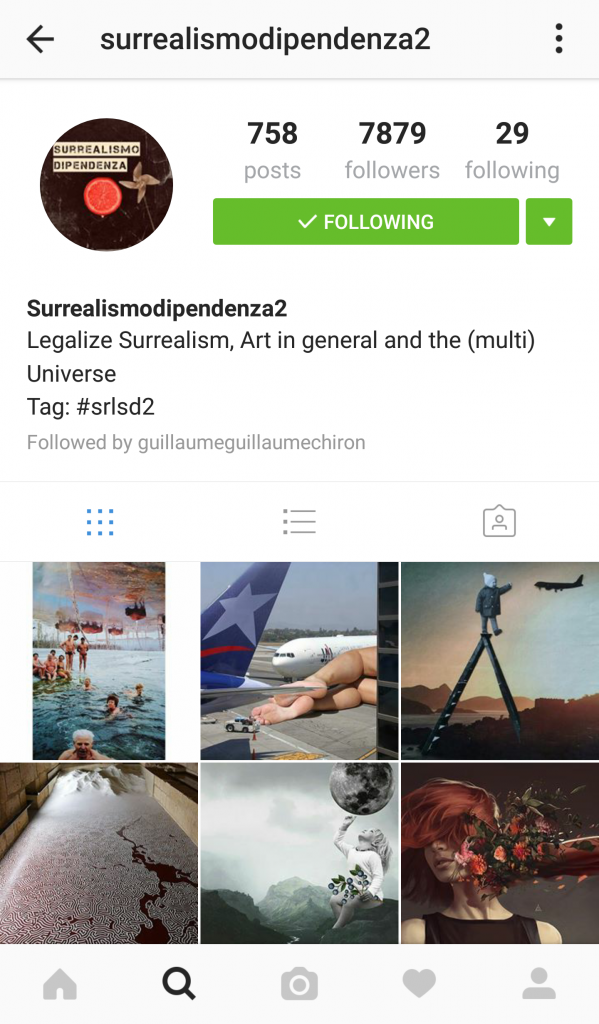
Instagram account where I drew my surrealism inspiration and ideas from.
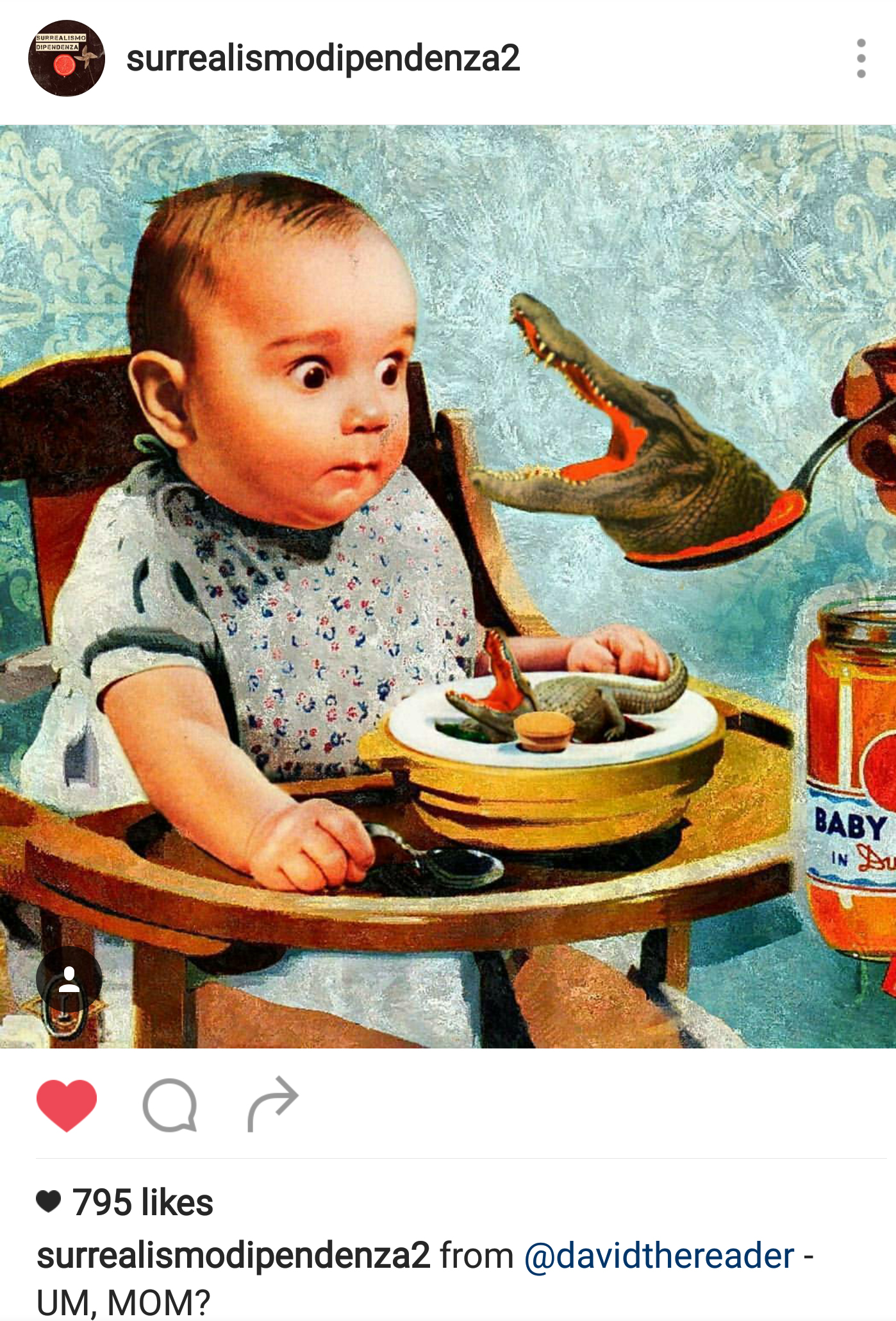
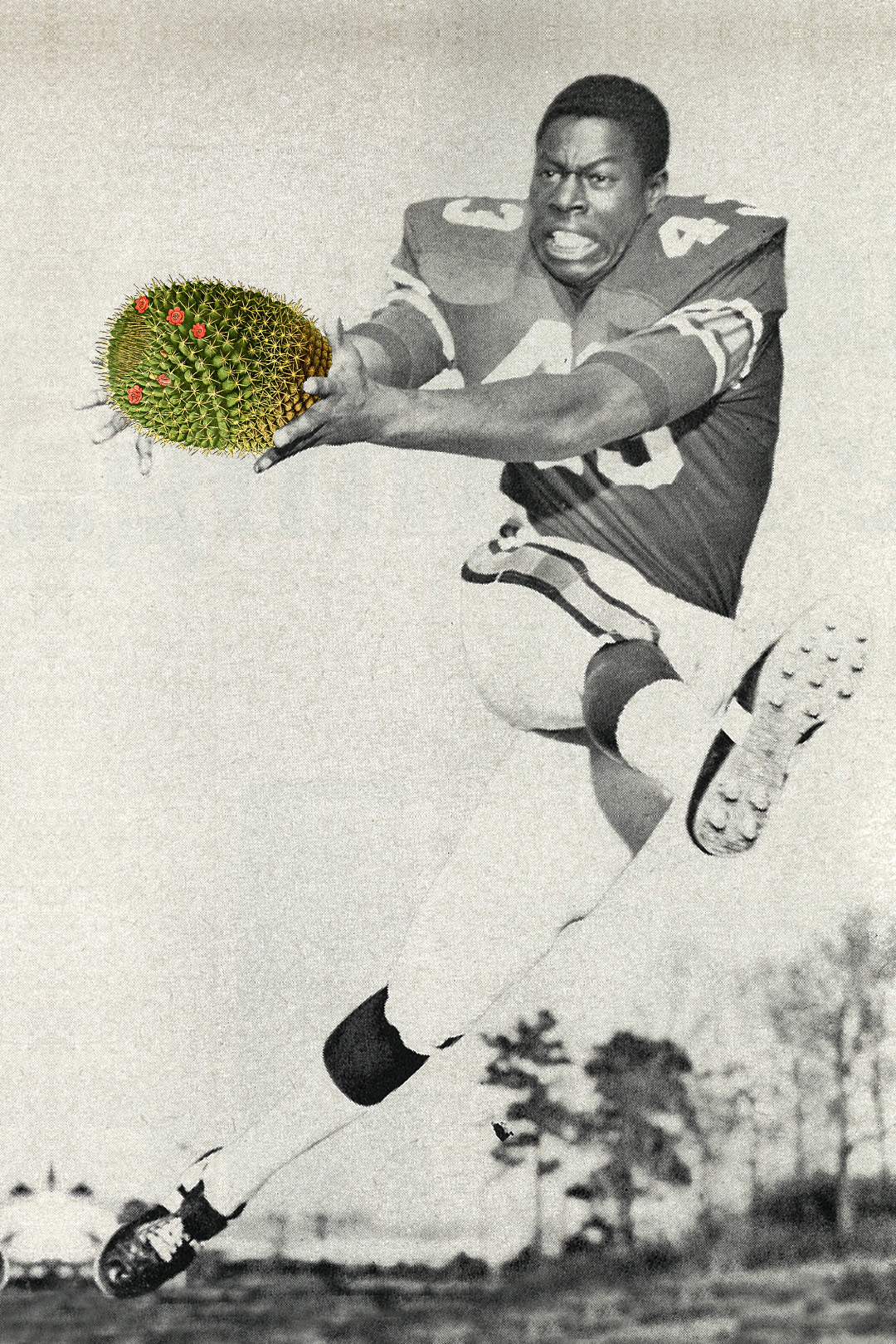

Inner struggles through Project 2:
Presentation Day Comments!
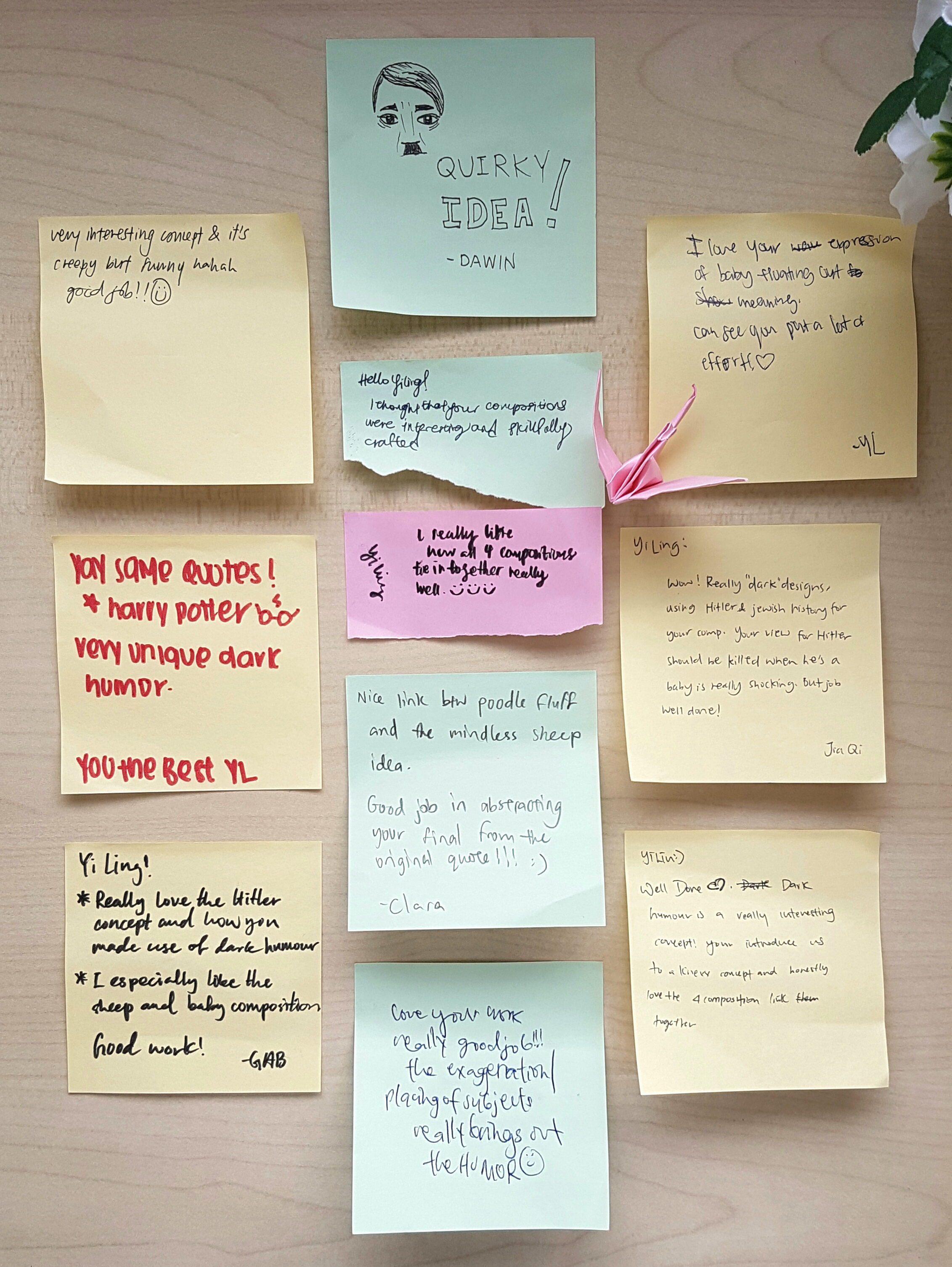
Ms. Joy’s comment/feedback:
I cant remember 100% of what Ms. Joy said, but the gist of the good things she said about my Project 2 was that she liked how I used the elements and principles of design in my work to direct the viewer’s attention to areas I wanted to focus on, and the use of dark humor with the reoccurring motif of Hitler in my various warm and fuzzy quotes were well played.
Whereas things to improve on is that the 2nd composition was a rather confusing as the visual weight of the hand and Hitler’s head are very similar, hence it was rather confusing if the hand was grabbing Hitler or the Jewish sheep as, Hitler’s facial expression looked scared. Joy also suggested that maybe averting the gaze of Hitler could assist in my composition to make Hitler look less afraid of the hand. 🙂
Regarding my silkscreened tote bag, we both agreed that the silkscreen pay off was not that good and that perhaps in the future I can have more opportunity to silkscreen again, and perhaps exposing my screen for a longer time will result in a better print! 😀
Thank you Ms. Joy and my lovely classmates for your feedback and comments!! To be honest, my favorite part for presentation day is getting the post-it notes from my classmates, and obtaining feedback. For some unknown reason it makes me feel very excited! ^0^
To be honest, my favorite part for presentation day is getting the post-it notes from my classmates, and obtaining feedback. For some unknown reason it makes me feel very excited! ^0^
Nonetheless, I had a really great experience with this project as I managed to use the principals of elements and design to create the design I wanted and then having to print them onto a tote bag! Having my design to be printed onto a product gave me a sense of achievement and a more tangible feeling of being a real designer. 
Cheers!
Seng Yi Ling
SILK SCREENING
It was my very first time at silk-screening on the previous week and I had trouble conceptualizing the process because I simply couldn’t fathom how our printed designs on TRANSPARENT PLASTIC (Correct term: Transparency Paper) could be translated onto printed designs on tote bag while using this sieve looking tool (Correct term: Silk Screening frame).
I had to see and have hands-on experience to believe this amazing invention created by mankind!
Firstly we were told to wash our silk screen frames and use a hair dryer to blow dry them, to ensure they were clean!
Then we went into this enclosed red room ( Red light was present) where NO LIGHT was allowed to be present as there might be some chemical reaction with the medium we were going to use. We then coated the netting of our frames on the back and front using the blue paint-like medium and then placing our coated frames in this GIAGANTIC oven (It had really smooth rolling trays…) to dry the medium !
After which we were taught by Xiuming (Work-study senior) to place our transparency and frame into this GIGANTIC MACHINE which looked like a photocopy machine on the outside, but had like reflective metal on the inside which made it look like a tanning machine. After which we locked our designs in the machine, it made a whirring sound and the cloth above our designs was like sucked in!!! I was super amused at this point because I had never seen anything like this before!
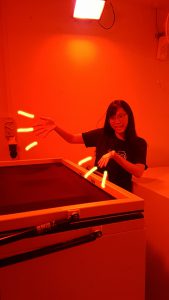
The Photocopy looking machine which printed our designs onto the silk screen frame surface 🙂
After which the machine did it’s job, we took our designs to the back of the room to wash the residue off using this jet spray (It was fun… pretending that the jet spray was a rifle  )! But in all honesty, I was rather upset at the amount of water wasted in this process of washing… considering that all of the students in ADM Year 1 had to do this, it is bad for the environment by wasting so much water. :'(
)! But in all honesty, I was rather upset at the amount of water wasted in this process of washing… considering that all of the students in ADM Year 1 had to do this, it is bad for the environment by wasting so much water. :'(
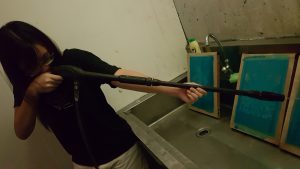
This jet spray allows the residue to be forced out of the net!
After cleaning up our designs on the frames, we used the hairdryer to dry the frame and apply a layer of thick ink over the top of our frame and pushed the ink across the designs using a wiper tool to ‘print’ our designs onto our tote bag!
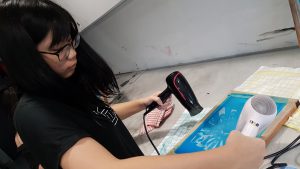
Drying the design
I wasn’t very please with the eventual outcome on the tote bag as some areas were too dark and splotchy instead of greyish, and details were missed out… As you can see it is pretty in-identical to my digital design.
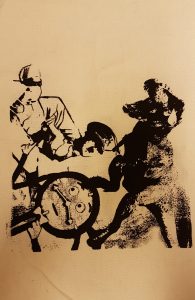
After test runs on paper, the final design has been printed on my tote bag!
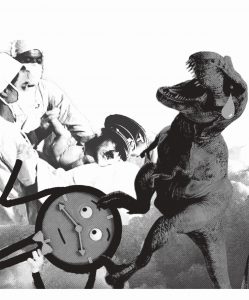 <<<Original digital design after bitmap
<<<Original digital design after bitmap
What I regretted the most after the final printing onto my tote bag was not being able to have a good gauge of what my final print will look like based on the tonal contrast, quality of the digital image and frequency of the dots in bitmap, BEFORE printing on the transparency paper … I hope that in the future I can have more opportunity to try out silk screening again. It was really fun! But at the same time, the process of silk screening was not easy at all; and I really do commend those who could do it so well! 
If my personal experience with silk screening is not detailed enough, do check out this video on how silk screening is conducted!!
Cheers!
Seng Yi Ling 
NEW PROJECT IS HERE!!
Our second project for 2D foundation class is called ‘Forrest Gump’! So let me start my research before we dive right into the course work!
Project Brief:
Create a visual narrative that expresses each movie quote of your choice using only symbols, pictograms, dingbats(ornaments), icons and engravings as your visual vocabulary.
The old engraving imagery puts the composition into historical context. You are to manipulate, alter and deconstruct the found graphic imagery to transcend its original meaning through the creation of the indicated narratives. Pay particular attention to the application of design principles to create visually engaging compositions.
~~~~~~~~~~~~~~~~~~~~~~~~~~~~~~~~~~~~~~~~~~~~~~~~~~~~~~
Symbols:

A mark that is universally recognized to represent an object, action or situation.
Pictograms:

Pictograms are pictorial symbols for a word or phrase. Pictographs were used as the earliest known form of writing, examples having been discovered in Egypt and Mesopotamia from before 3000 BC.

Pictograms are also used as pictorial representation of statistics on a chart, graph, or computer screen.
Dingbats:
A dingbat is an ornament (used for decoration/embellishment), character, or spacer used in typesetting (composition of texts), often employed for the creation of box frames.

The term continues to be used in the computer industry to describe typeface that have symbols and shapes in the positions designated for alphabetical or numeric characters.
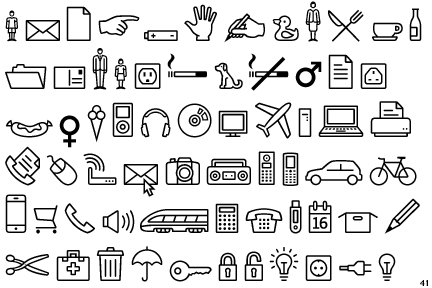
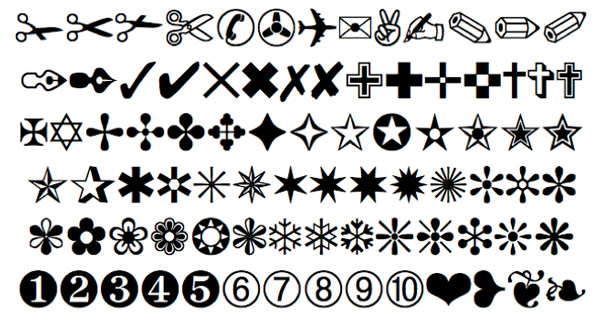
In summary, I understand Dingbats as a form of ornamental embellishment OR symbols or shape that acts as a semiotic. (Correct me if I am wrong  )
)
Icons:

Icon has a physical resemblance to the signified, the symbol being represented and is usually a pictorial representation.
Engravings:


Engraving is putting a design onto a hard, flat surface (stone, wood, metal etc.), by carving into it resulting in a decorative piece.

Or may provide a printing plate of copper or another metal, for printing images on paper which are also called engravings.
~~~~~~~~~~~~~~~~~~~~~~~~~~~~~~~~~~~~~~~~~~~~~~~~~~~~~
More research will be done on my visual journal starting from this project onwards (I hope), and I will be uploading images of my journal in the furure!
Cheers,
Seng Yi Ling~
Today I tried to do some self exploration on the marks I can create with some of the mediums at home, bearing in mind with the suggested solutions I came up with in my previous post! So I began my journey into mark making with an open mind with no expectations of myself, except to just have fun with mark making first! 🙂
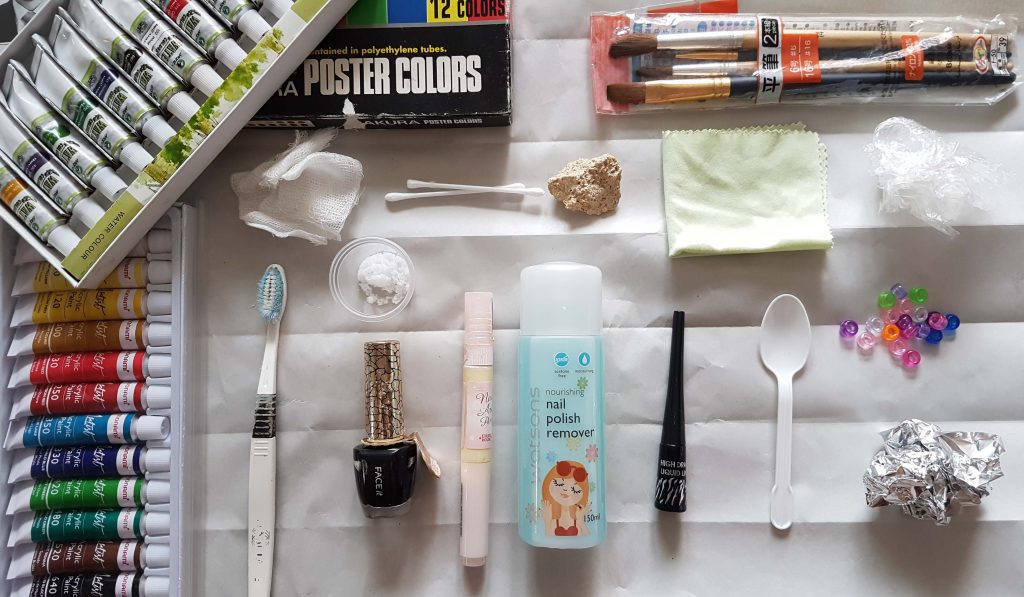 Image 1: My tools and mediums used: Acrylic paint, Watercolor paint, Poster color paint, cotton mesh, straw, an old tooth brush, a tea spoon of salt, nail varnish, Q-tips, a rock, nail polish remover, different sizes of paintbrushes, cloth, eyeliner, plastic teaspoon, scrunched up cling wrap, beads and scrunched up aluminum foil.
Image 1: My tools and mediums used: Acrylic paint, Watercolor paint, Poster color paint, cotton mesh, straw, an old tooth brush, a tea spoon of salt, nail varnish, Q-tips, a rock, nail polish remover, different sizes of paintbrushes, cloth, eyeliner, plastic teaspoon, scrunched up cling wrap, beads and scrunched up aluminum foil.
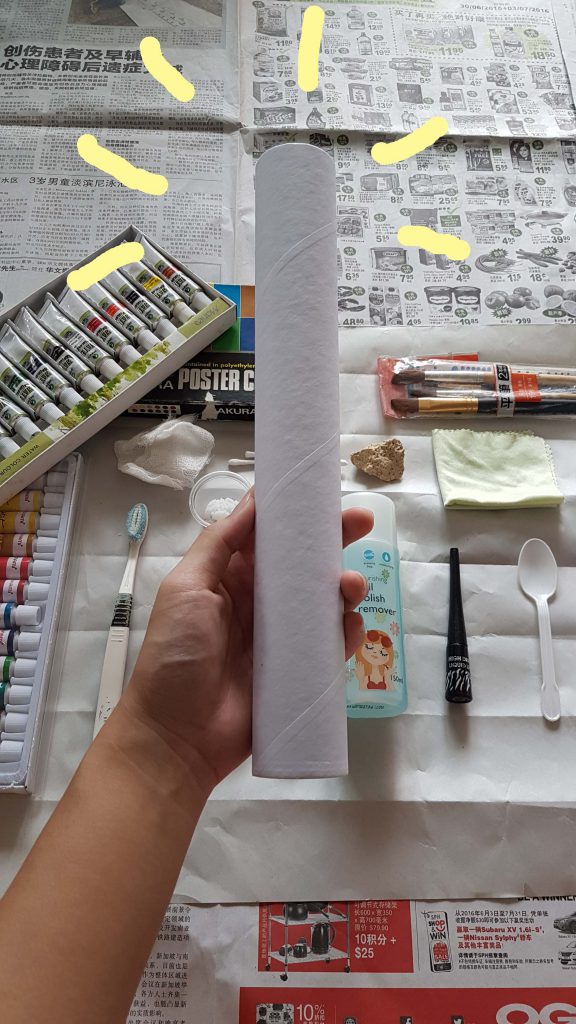 Image 2: Because I didn’t have a roller like the mono-printing post previously, I used a kitchen towel cardboard tube as a… low-budget roller. Hope that it works just as well.
Image 2: Because I didn’t have a roller like the mono-printing post previously, I used a kitchen towel cardboard tube as a… low-budget roller. Hope that it works just as well.
I was very interested in knowing how each unconventional medium would react with the other. For instance, mixing acrylic paint with nail varnish / mixing watercolor paint with nail polish remover. Hoping that upon my experimentation I would discover a texture or pattern the 2 mediums could produce. Will they be miscible? Or no reaction will be observed?
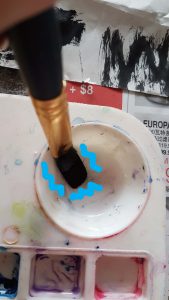 << Image 3: I tried mixing watercolor paint with nail polish remover and to my surprise and excitement, the 2 mediums are not completely miscible! Black paint coagulations were found at the bottom of the palette.
<< Image 3: I tried mixing watercolor paint with nail polish remover and to my surprise and excitement, the 2 mediums are not completely miscible! Black paint coagulations were found at the bottom of the palette.
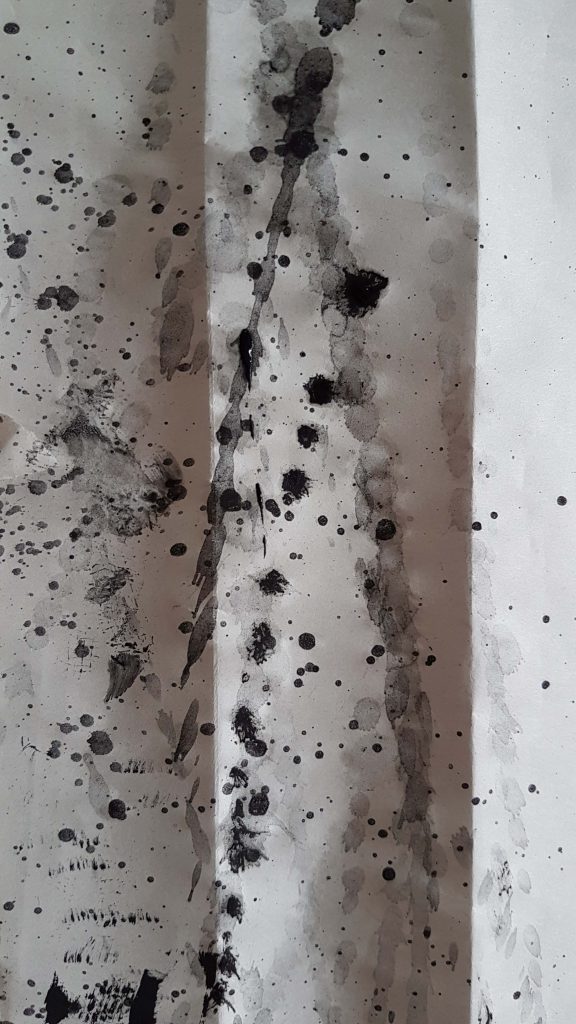 Image 4: After vigorously mixing the mediums in image 3, I swung my wet paintbrush onto the newsprint paper, creating far-ranged splatter patterns.
Image 4: After vigorously mixing the mediums in image 3, I swung my wet paintbrush onto the newsprint paper, creating far-ranged splatter patterns.
My first attempt at doing mark making without much visual aesthetic thoughts was considered pretty successful. I was intrigued at how far the splatter could go and the intensity of each splash as I channeled my inner Jackson Pollock. Soon I realized that this is a rather fun and cathartic activity!
I felt more carefree while being more bold in my strokes and actions (as I have already placed a lot of newspaper around me to prevent unwanted marks on my furniture at home) and I felt less restricted and more daring in my choice of mediums than before.
Then I went on to try out using nail varnish and nail polish remover!
 Image 5: I cut open a tube of white nail varnish and poured it over the newsprint, and then adding a few drops of black nail varnish onto the white.
Image 5: I cut open a tube of white nail varnish and poured it over the newsprint, and then adding a few drops of black nail varnish onto the white.
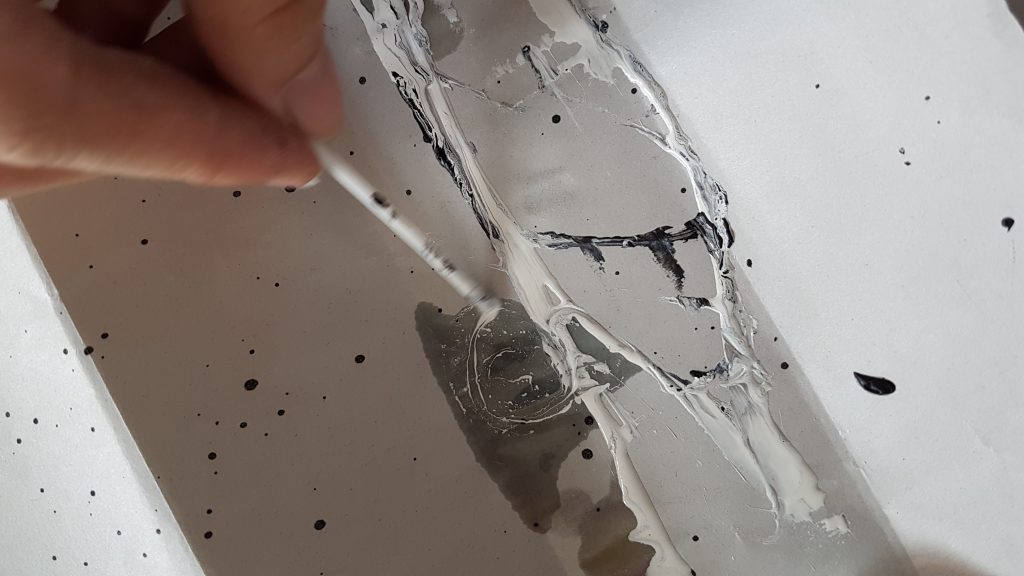 Image 6: I then used the plastic teaspoon to pour nail polish remover over the white nail varnish, and then using a Q-tip (with the cotton portion cut off) to swirl the mixture; creating another pattern that is a result of 2 immiscible mediums!
Image 6: I then used the plastic teaspoon to pour nail polish remover over the white nail varnish, and then using a Q-tip (with the cotton portion cut off) to swirl the mixture; creating another pattern that is a result of 2 immiscible mediums!
Then I began trying out using a very fluid medium like black watercolor paint, and then using a straw to blow at the paint. Creating an unpredictable pattern that goes in different directions according to the dispersion of wind emitted from the straw.
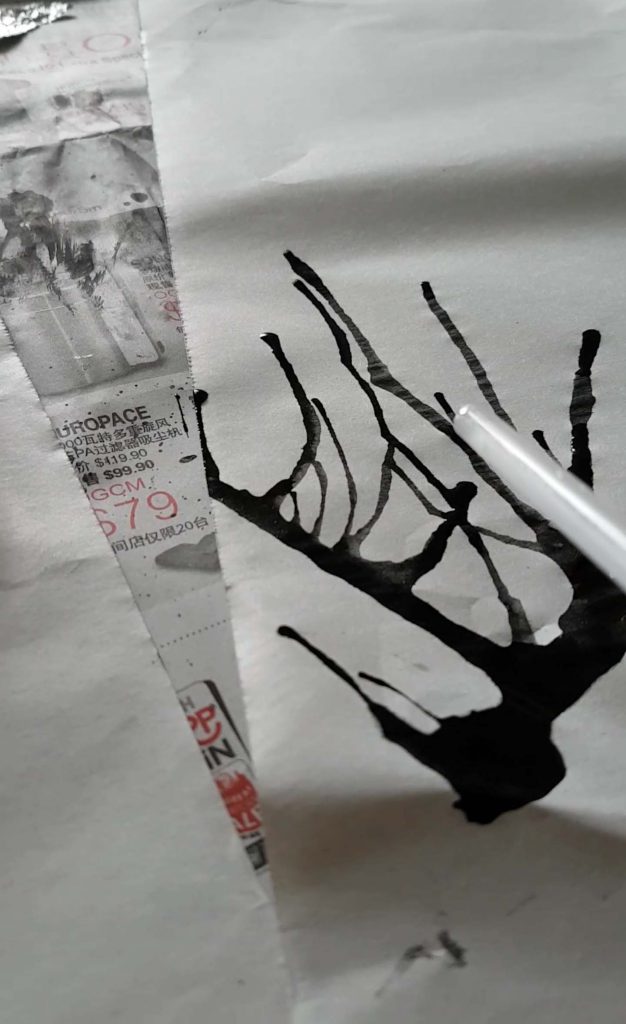 Image 7: Blowing air out from a straw onto an A2 newsprint with fluid black watercolor paint.
Image 7: Blowing air out from a straw onto an A2 newsprint with fluid black watercolor paint.
The distance of the paint travelled varies, depending on the amount of air I exhaled from my weak lung capacity. Distance of paint travelled decreases with time as the ink has already been spread, and I was very out of breath…
Then I was inspired to recreate an artwork I did as a child! The one whereby my kindergarten teacher gave us marbles coated with different colored paint, and a clean A4 sized paper in a paper box cover. She told us to place the marbles in the box cover with the paper and shake it. Resulting an unpredicted abstract pattern created by the colored marbles rolling in the box!
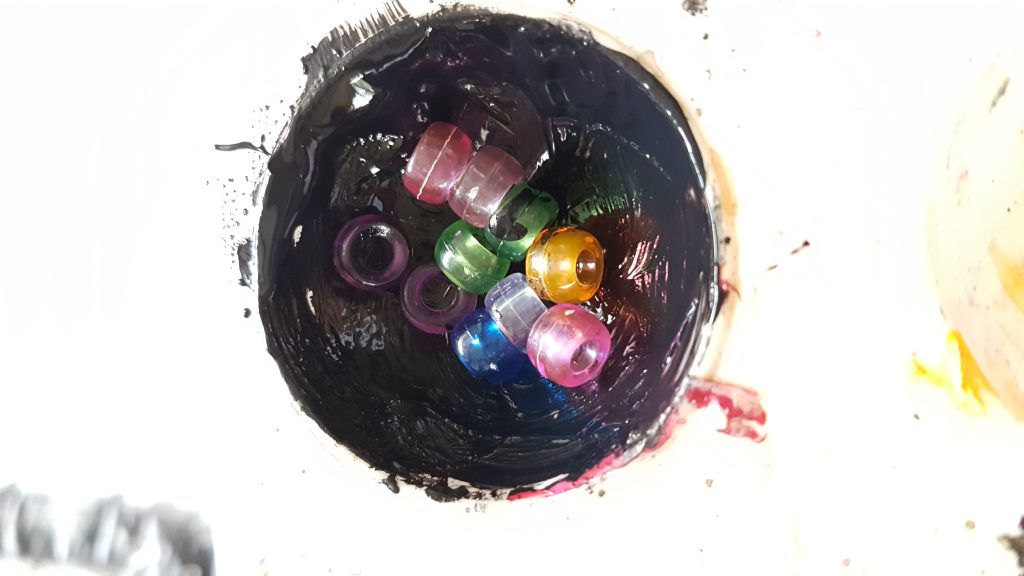 Image 8: I didn’t have marbles so I used beads and coated them in dense poster color paint.
Image 8: I didn’t have marbles so I used beads and coated them in dense poster color paint.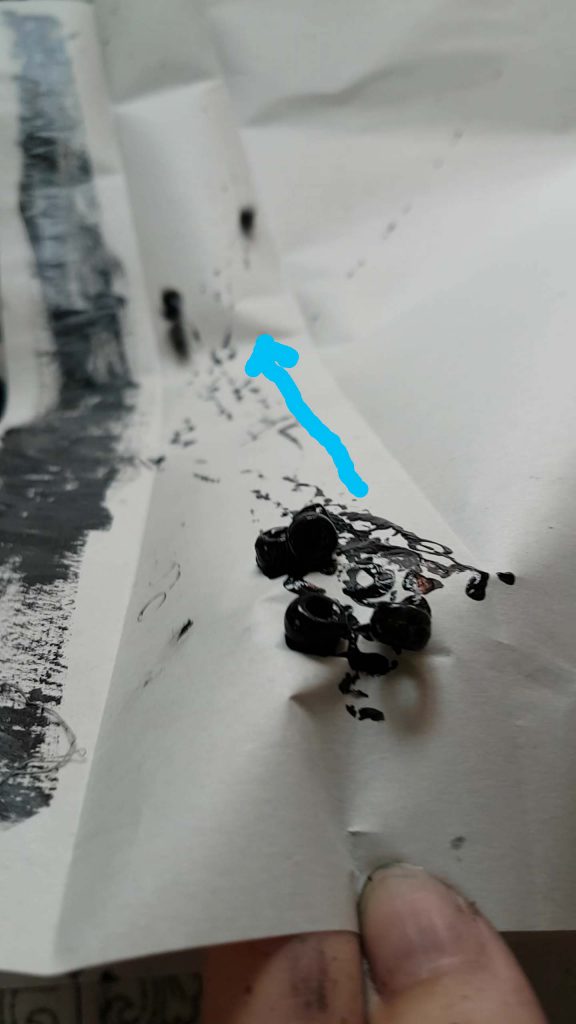 Image 9: I tilted the paper in an angle and allowed the beads to roll downwards, creating a linear rolling pattern that goes in different direction.
Image 9: I tilted the paper in an angle and allowed the beads to roll downwards, creating a linear rolling pattern that goes in different direction.
Afterwards I tried to recreate what I have learnt in mono-printing class, but didn’t do so well as my choice of medium was not thick enough.


Image 10 and 11: I resulted in painting one size of my scrunched up aluminum foil and then rolling it across the newsprint paper with my kitchen towel cardboard tube.
 Image 12: I also used a scrunched up cling wrap dipped in paint to dab it all over my newsprint. Creating a blotchy and detailed patterns as the pain began to dry a little.
Image 12: I also used a scrunched up cling wrap dipped in paint to dab it all over my newsprint. Creating a blotchy and detailed patterns as the pain began to dry a little.
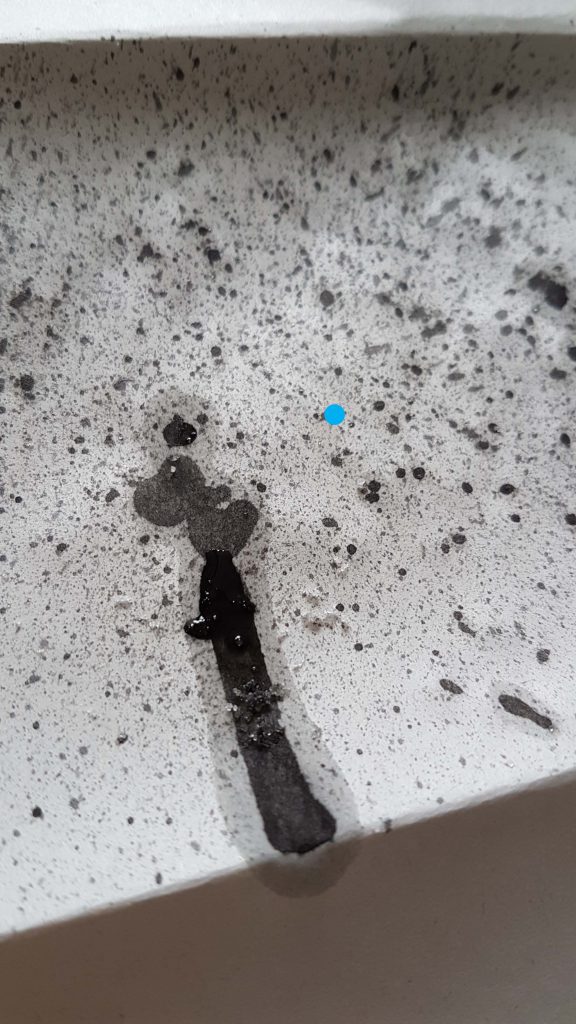 Image 13: Incorporating a tooth brush, I created tiny splattered patterns . The blotchy watercolor paint drip was created by accident. So I decided to add some salt crystals onto it, hoping to achieve a water color to gather the water pigments. But the experimentation has failed as the paper absorbed the water color more efficiently than the salt could.
Image 13: Incorporating a tooth brush, I created tiny splattered patterns . The blotchy watercolor paint drip was created by accident. So I decided to add some salt crystals onto it, hoping to achieve a water color to gather the water pigments. But the experimentation has failed as the paper absorbed the water color more efficiently than the salt could.
These are just some of the mark making process I have documented! In conclusion for my first self exploration of mono-printing, I think the results were rather successful ! Though I took videos of how the process of each mark making attempt was done, sadly, I couldn’t upload the video as the file is too big and the format of the video is incompatible. 🙁
But still! The results of the final products were rather fine and I liked how each mark has its own feeling and different textures and patterns to it. :)4
Until next time~
Cheers,
Yi Ling.
At first glance into the research of Automatic drawing, it is fairly similar to Mark Making. But let me dive deeper into the research to confirm my hypothesis. Lets go! 
What is Automatism?
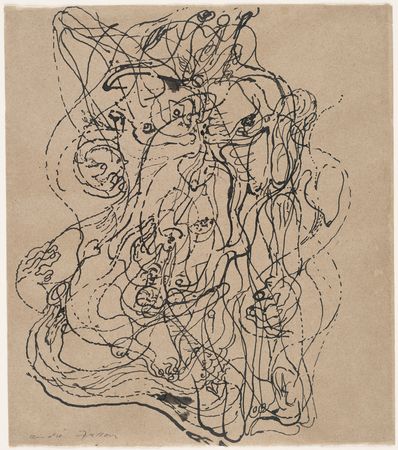
Automatic Drawing (1924)
André Masson
Ink on paper
(23.5 × 20.6 cm).
“Automatism” most often refers to a technique of subconscious drawing in which the artist allows his unconscious mind to take control. It is the primary method of surrealism.
Automatism is a sort of accelerated or intensified gestural movements. Unexpected and unpredicted images can be made to appear, while avoiding conscious control over the image.
Automatic techniques not only involves doodling or marking marks on paper.
Some other automatic techniques include:
Grattage
Grattage is a surrealist painting technique that involves laying a canvas prepared with a layer of oil paint over a textured object and then scraping the paint off to create an interesting and unexpected surface
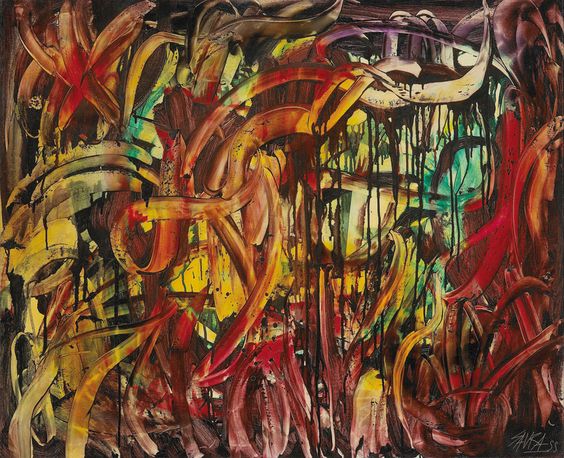
Max Ernst
Forest and Dove 1927
Oil on canvas
support: 1003 x 813 mm
frame: 1200 x 1012 x 66 mm
Frottage
Frottage is a surrealist and ‘automatic’ method of creative production that involves creating a rubbing of a textured surface using a pencil or other drawing material
Phoenix Landing
2003
Roger Clark Miller
Fumage
Fumage is a technique in which an image is created by painting with smoke from a lighted candle into a ground of wet paint.
Fumage, gouache, and color pencil work, by Antonio Muñiz
1955
Oil, sand and glue on canvas
551 x 380 mm
Sand painting
Sand painting is the art of pouring colored sands, and powdered pigments from minerals or crystals, or pigments from other natural or synthetic sources onto a surface to make a fixed, or unfixed sand painting.
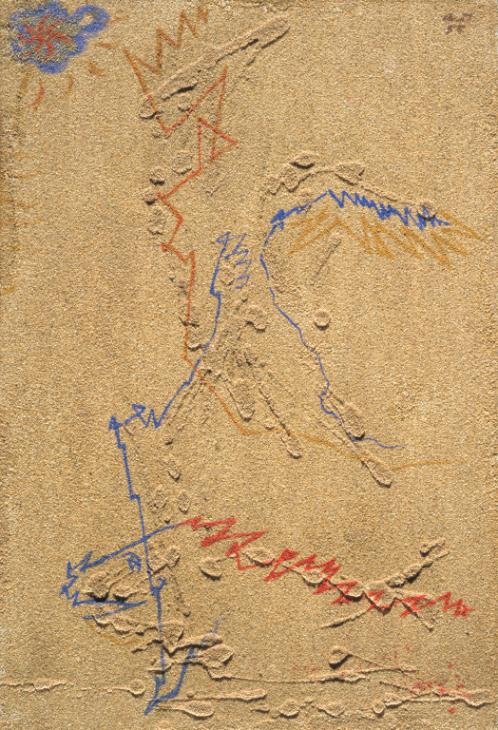
André Masson
Star, Winged Being, Fish 1955
Froissage
Froissage is a method of collage in which the lines made by crumpling up a piece of paper are used to create a drawing.
Torn paper collage etc.
Paper collage is a technique of an art production where the artwork is created using an assemblage of different forms and shapes using paper.

When did Automatism begin?
Popularized during the 20th century by Surrealist artists, they sought to unleash the creative force of the unconscious in art.
The Surrealists embraced automatic drawing as way to incorporate the subconscious into their artwork, and to free themselves from artistic conventions, social norms and everyday thinking.
Automatic drawing and painting was seen as the only way then to escape from cultural, intellectual and historical constraints and unlock the basic creativity supposedly lodged deep within the artist’s personality. This technique, Surrealists felt, was a way in to access meaning and information that were unavailable through tradition and the conscious mind.
Impact Automatism had ?
Apart from Surrealism, other movements/ group in which Automatism has played a role includes: Dadaism ( In the early 20th Century), the gestural style of Action Painting and a late-1940s Canadian artist group known as Les Automatistes.
Probably the most famous painters associated with automatic art are Salvador Dali (1904-89) and Jackson Pollock (1912-56). Since the 1930s, Automatism has become a part of the technical repertoire of both modern and postmodern art.

What I admire about automatic drawing is that it is an immediate way to start creating art. It can be done when one feels completely uninspired or faced with a mental block due to lack of ideas. Automatism is a great way to free your creativity. It lifts you out of your logical brain’s desire to make something that’s “good” or “accurate”, unleashing your subconscious mind and breaking free from societal constraints!
Hence, to conclude the research. I feel that Automatic drawing incorporates mark making. Automatic drawing is the idea, and mark making is the technique to carry it out. 
Mark making is a term used to describe the different lines, patterns, and textures we create in an artwork.
It applies to any art material we use on any surface. A dot made with a pencil, a line created with a pen, a swirl painted with a brush, these are all types of mark making.
https://www.youtube.com/watch?v=WZ5ConE6kgM
The above link is a brief video on how mark making can be done. The ways of mark making are free and limitless!
 Mark making can be loose and gestural, or structured and controlled. Zen-like doodles, expressive and emotive paint throwing techniques and simply rubbing a stick/ comb/ toilet brush (??) through some acrylic paint are just some of the many creative ways mark making can be done!
Mark making can be loose and gestural, or structured and controlled. Zen-like doodles, expressive and emotive paint throwing techniques and simply rubbing a stick/ comb/ toilet brush (??) through some acrylic paint are just some of the many creative ways mark making can be done!
But in Project 1 “My line is emo”; my project restricts me to have a black and white outcome in the end, as well as avoiding illustrating emotions literally or creating anything representational… Come on now brain, time for my creative juices to start flowing through my Factory of Creations~
Come on now brain, time for my creative juices to start flowing through my Factory of Creations~

According to the trustworthy search engine: Google, it seems like there is no exact date as to when mark making was officially introduced. It just happened! So in my assumptions, I suppose mark making began when mankind discovered art! Because making patterns or tracing your fingers with a medium that shows a physical and permanent mark, is after all a pictorial attempt at mark making isn’t it? 

Mark making has been used frequently as an expressive leisure form of art work, art therapy as well as a form of expression and development for children during early childhood.
According to the book ‘Navigating Art Therapy: A Therapist’s Companion’ by Chris Wood, mark making has served as a form of therapy for the physical, spiritual and mental health for humans.
“Indigenous mark-making has been associated, since prehistoric times, with understanding the connections between interior and exterior. Spiritual and religious rituals have also used mark making in aspects concerning health, healing and the sustaining of life.”
-Page 16, Navigating Art Therapy: A Therapist’s Companion by Chris Wood
Mark making has been done by everyone in one way or another, regardless of an accidental or intended attempts.
For instance, when you accidentally knocked your colored beverage onto your homework, and despite the momentary hysteria, you’re like, “Wow, this is a rather gorgeous splatter I have created by accident!” (true story).
Some artists who has taken mark making into the next level, and are very good at it are:

Kabul
2013
Graphite and acrylic on linen
96 x 144 in. (243.8 x 365.8 cm)
Mehretu’s work conveys a layering and compression of time, space and place and a collapse of art historical references, from the dynamism of the Italian Futurists and the geometric abstraction of Malevich to the enveloping scale of Abstract Expressionist color field painting.
In her highly worked canvases, Mehretu creates new narratives using abstracted images of cities, histories, wars and geographies with a frenetic mark making that for the artist becomes a way of signifying social agency as well suggesting an unravelling of a personal biography.
 Grande Anthropophagie bleue
Grande Anthropophagie bleueThe Grande Anthropophagie bleue. Hommage a Tennessee Williams is an accurate reflection of the fragility and suffering. In reference to the final scene of Tennessee Williams’ Suddenly Last Summer, adapted for the screen by Joseph Mankiewics in 1959, the work is an expression of great violence by the chaos and force of its marks
Klein presented his work in forms that were recognized as art but would then take away the expected content of that form (paintings without pictures, a book without words, a musical composition without in fact composition) leaving only a shell. He wanted his subjects to be represented by their imprint: the image of their absence.
 Pollock also incorporates the use of different unconventional mediums. Instead of using the traditional paint brush, he would add depth to his images using knives, trowels, sticks and even his own foot prints as part of the artwork, as he works while standing IN his monumental artwork. In that it had a direct relation to the artist’s emotions, expression, and mood, and showcased their feeling behind the pieces they designed. Thus, achieving different patterns and forms in midst of his expressive mark making.
Pollock also incorporates the use of different unconventional mediums. Instead of using the traditional paint brush, he would add depth to his images using knives, trowels, sticks and even his own foot prints as part of the artwork, as he works while standing IN his monumental artwork. In that it had a direct relation to the artist’s emotions, expression, and mood, and showcased their feeling behind the pieces they designed. Thus, achieving different patterns and forms in midst of his expressive mark making.
Jackson Pollock’s Autumn Rhythm (Number 30)
1950
Enamel on canvas
105 x 207 in. (266.7 x 525.8 cm)
With that, I conclude my first round of research into mark making.
Cheers!
Yi Ling 
References for research:
http://painting.about.com/od/artglossarym/g/definition-mark-making.htms
http://whitecube.com/artists/julie_mehretu/
http://www.jackson-pollock.org/autumn-rhythm.jsp